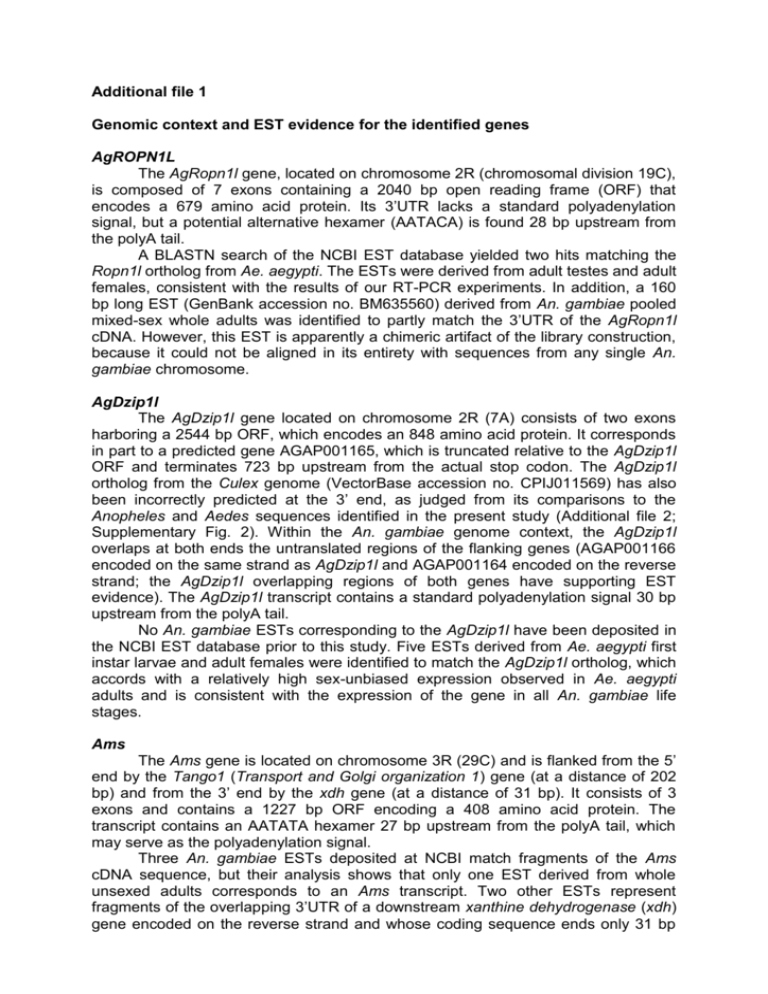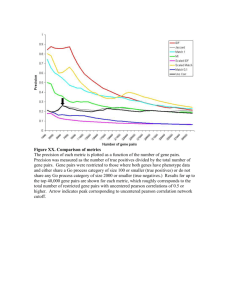file - BioMed Central
advertisement

Additional file 1 Genomic context and EST evidence for the identified genes AgROPN1L The AgRopn1l gene, located on chromosome 2R (chromosomal division 19C), is composed of 7 exons containing a 2040 bp open reading frame (ORF) that encodes a 679 amino acid protein. Its 3’UTR lacks a standard polyadenylation signal, but a potential alternative hexamer (AATACA) is found 28 bp upstream from the polyA tail. A BLASTN search of the NCBI EST database yielded two hits matching the Ropn1l ortholog from Ae. aegypti. The ESTs were derived from adult testes and adult females, consistent with the results of our RT-PCR experiments. In addition, a 160 bp long EST (GenBank accession no. BM635560) derived from An. gambiae pooled mixed-sex whole adults was identified to partly match the 3’UTR of the AgRopn1l cDNA. However, this EST is apparently a chimeric artifact of the library construction, because it could not be aligned in its entirety with sequences from any single An. gambiae chromosome. AgDzip1l The AgDzip1l gene located on chromosome 2R (7A) consists of two exons harboring a 2544 bp ORF, which encodes an 848 amino acid protein. It corresponds in part to a predicted gene AGAP001165, which is truncated relative to the AgDzip1l ORF and terminates 723 bp upstream from the actual stop codon. The AgDzip1l ortholog from the Culex genome (VectorBase accession no. CPIJ011569) has also been incorrectly predicted at the 3’ end, as judged from its comparisons to the Anopheles and Aedes sequences identified in the present study (Additional file 2; Supplementary Fig. 2). Within the An. gambiae genome context, the AgDzip1l overlaps at both ends the untranslated regions of the flanking genes (AGAP001166 encoded on the same strand as AgDzip1l and AGAP001164 encoded on the reverse strand; the AgDzip1l overlapping regions of both genes have supporting EST evidence). The AgDzip1l transcript contains a standard polyadenylation signal 30 bp upstream from the polyA tail. No An. gambiae ESTs corresponding to the AgDzip1l have been deposited in the NCBI EST database prior to this study. Five ESTs derived from Ae. aegypti first instar larvae and adult females were identified to match the AgDzip1l ortholog, which accords with a relatively high sex-unbiased expression observed in Ae. aegypti adults and is consistent with the expression of the gene in all An. gambiae life stages. Ams The Ams gene is located on chromosome 3R (29C) and is flanked from the 5’ end by the Tango1 (Transport and Golgi organization 1) gene (at a distance of 202 bp) and from the 3’ end by the xdh gene (at a distance of 31 bp). It consists of 3 exons and contains a 1227 bp ORF encoding a 408 amino acid protein. The transcript contains an AATATA hexamer 27 bp upstream from the polyA tail, which may serve as the polyadenylation signal. Three An. gambiae ESTs deposited at NCBI match fragments of the Ams cDNA sequence, but their analysis shows that only one EST derived from whole unsexed adults corresponds to an Ams transcript. Two other ESTs represent fragments of the overlapping 3’UTR of a downstream xanthine dehydrogenase (xdh) gene encoded on the reverse strand and whose coding sequence ends only 31 bp from the end of the Ams transcript. Despite the EST evidence, the gene has not yet been annotated and included in the An. gambiae gene build. No ESTs corresponding to Ams ortholog from Aedes have been found at NCBI. mts The mts gene consists of two exons and contains an 897 bp ORF encoding a 295 amino acid protein. A BLASTN search of the An. gambiae PEST strain genome using the full length cDNA as a query resulted in two hits. One hit corresponds to a scaffold (AAAB02008898) mapped to the chromosome 2R (19C). The other hit is to a short unmapped scaffold (AAAB01000967) that evidently represents an alternative assembly of the same genomic region, because Southern blot analysis does not support the presence of two gene copies within the genome (data not shown). Interestingly, two copies of the homologous gene were found in the Aedes genome (within genomic supercontigs 1.453 and 1.414). High nucleotide sequence identity (96%) of both copies within both coding and non-coding regions suggests that the duplication in Aedes may have occurred very recently. The An. gambiae mts transcripts were not represented in the NCBI EST database at the time of our study, however, three Ae. aegypti ESTs derived from testis and eight from the females infected with Bruggia malayi and dengue virus were identified to match the mts ortholog. The EST data from females contradict our RTPCR results, which indicate male-specific expression of that gene in Aedes. It is conceivable that transcripts detected in Aedes females result from misexpression of the gene due to infection, although currently this supposition remains speculative. AAms The AAms gene is located on the chromosome 2R (16E). According to the RT-PCR results, the gene encodes two transcripts expressed in testis (Fig. 1). One transcript consists of two exons, which harbor a 3567 bp ORF coding for a 1188residue protein. The second transcript, characterized by a shorter ORF generated by a transcript-specific intron splicing event (cf. Additional file 2; Supplementary Fig. 5), apparently encodes a truncated protein form (since the structure of this transcript was not analyzed in details, we do not have any experimental evidence regarding its ends; however, the protein truncation is suggested by the in-frame stop codon present 41 nucleotides downstream from the splice acceptor site). No ESTs corresponding to the AAms gene or its orthologs were submitted to the NCBI database prior to our study. Table 1. Mosquito ESTs deposited at NCBI and searched using full length sequences of genes identified in this study as queries. An. gambiae Ae. aegypti Cx. quinquefasciatus Testis Unsexed preimaginal stages - 23,686 2,779 - cDNA source Mixed sex whole adults Whole adult females and female tissues Total 82,926 46,553 153,165 62,064 - 236,499 301,342 - 57,262 147,480 204,742 Table 2. Primers used for the RT-PCR analyses of expression of genes identified in this study (cf. Fig 1 and 2). For each gene and species the forward (F) and the reverse (R) primer sequences are given in 5’-3’ orientation. Gene An. gambiae Ae. aegypti Cx. quinquefasciatus Ropn1l F R GCGTAGAAGAAAAACACAAAAGCAT TGGCTGCGTTCGTATTACCG GTTCGTCGATGGGAGAAAAG TCACACTCCCCGTCGATAAT TGTGGATGTTCAAGGAGTGC AAATCGCCACCGTACTCAAC Dzip1l F R GGCCAAAGTGATACAAATTGTTT CGTTTCCAATAGGGACTTCG CGAATGAAGCCAAACAAGACC AGAGACATTACTTCGTGACAGC AGTTTCGCCAAAGAAGCAGA GTTGTGCCGCTACCTTGTTT Ams F R CATACGGGAGGTGAGGAAAT CCCCTTCATGCTTCATCTT TTCGAGACGCTCAAGTACGA CTCACGGTCCTTTTCGATGT TTCGAGAGTCTCAAGCACGA CCAGCTCGTAGTCCTTTTCG mts F R TGGGATCCAAATTATTTCGTG CTGTTCGGTTCAACAATGGA CGCTAATTCCGGAGTGAAAA GGGGATCGATTTACCCAGAT GAGAATTCCTCCGTGACAGC ATGGCACCATCAGTTTCCTC AAms F R ACCCTACACCTGCTTCTTCG CGCACTCCATCACCGATTC CGATCCTCCGGAGTTAACAA TGTGCAACGACTCTTGAAGG TGAAGCACAGCCTATCGTTG CGTTTGCTGGAAAAGTACCC Table 3. Details on SSH fragments lacking male expression bias. Annotation status1 Female EST subC1 subC2 subC3 subC4 subC7 subC9 subC10 GenBank accession GO479231 GO479232 GO479233 GO479234 GO479235 GO479236 GO479237 XM_563568.1 XM_316348.4 XM_313971.4 XM_001238121.2 XM_319271.3 XM_315091.3 XM_001238567.2 subC11 subC12 subC13 subC15 subC16 subC17 subC18 GO479238 GO479239 GO479240 GO479242 GO479243 GO479244 GO479245 subC19 subC20 subC21 subC22 Clone No No Yes No No Yes Yes Best Blastx match AGAP002593 AGAP006283 AGAP005095 AGAP012875 AGAP010117 AGAP004987 AGAP001174 % identity/E value 100/9e-45 100/6e-17 100/8e-45 95/ 3e-33 96/3e-40 98/ 2e-50 99/6e-72 XM_312231.3 XM_311486.4 XM_312551.2 Unannotated Unannotated XM_313417.4 XM_312474.4 No Yes Yes Yes Yes Yes Yes AGAP002691 AGAP010461 AGAP002401 AGAP003649 AGAP002465 100/1e-17 100/ 2e-15 100/3e-32 90/4e-30 98/6e-51 GO479246 XM_318947.4 Yes AGAP009833 98/2e-39 GO479247 GO479248 GO479249 XM_314556.3 XM_320350.4 XM_559853.2 Yes Yes Yes AGAP010591 AGAP012185 AGAP009368 99/4e-61 98/1e-66 100/ 6e-17 1GenBank Homologue of known function apolipoprotein cuticular protein 70 beta-actin cuticular protein 99 cuticular protein 95 14.5 kDa salivary peptide Histone H1 vacuolar ATP synthase subunit e zinc finger protein ferritin heavy chain-like protein precursor voltage-dependent anionselective channel 40S ribosomal protein S20 coracle protein - accession numbers of annotated mRNAs that match full length of the SSH fragments are given in bold, those that match portions of the SSH fragments are given in italic.









